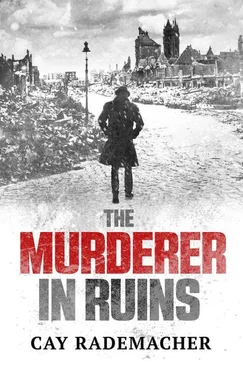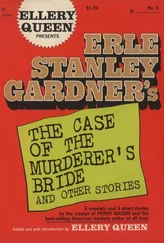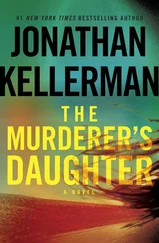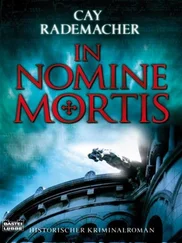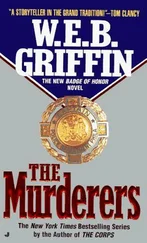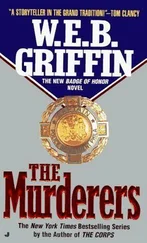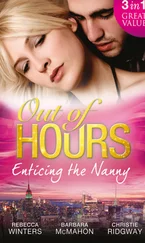Cay Rademacher - The Murderer in Ruins
Здесь есть возможность читать онлайн «Cay Rademacher - The Murderer in Ruins» весь текст электронной книги совершенно бесплатно (целиком полную версию без сокращений). В некоторых случаях можно слушать аудио, скачать через торрент в формате fb2 и присутствует краткое содержание. Год выпуска: 2015, ISBN: 2015, Издательство: Arcadia Books Limited, Жанр: Триллер, на английском языке. Описание произведения, (предисловие) а так же отзывы посетителей доступны на портале библиотеки ЛибКат.
- Название:The Murderer in Ruins
- Автор:
- Издательство:Arcadia Books Limited
- Жанр:
- Год:2015
- ISBN:9781910050750
- Рейтинг книги:5 / 5. Голосов: 1
-
Избранное:Добавить в избранное
- Отзывы:
-
Ваша оценка:
- 100
- 1
- 2
- 3
- 4
- 5
The Murderer in Ruins: краткое содержание, описание и аннотация
Предлагаем к чтению аннотацию, описание, краткое содержание или предисловие (зависит от того, что написал сам автор книги «The Murderer in Ruins»). Если вы не нашли необходимую информацию о книге — напишите в комментариях, мы постараемся отыскать её.
The Murderer in Ruins — читать онлайн бесплатно полную книгу (весь текст) целиком
Ниже представлен текст книги, разбитый по страницам. Система сохранения места последней прочитанной страницы, позволяет с удобством читать онлайн бесплатно книгу «The Murderer in Ruins», без необходимости каждый раз заново искать на чём Вы остановились. Поставьте закладку, и сможете в любой момент перейти на страницу, на которой закончили чтение.
Интервал:
Закладка:
Stave was taken aback for a minute. Two women, an old man, a little girl – did that fit a pattern any better?
The uniform led the way. ‘The building at 52 Anckelmann Strasse is completely in ruins,’ he explained. ‘We could get to the cellar by going through the ruins, but it’s easier this way.’
He led Stave and Maschke some 50 metres along the street to a neighbouring building, which had only partly collapsed. A reinforced archway there led to several partly collapsed internal yards, through which they made their way back in the other direction.
Stave stopped outside the remains of a commercial storeroom. ‘The Hanseatic Mica Import Company’ was written in faded black letters against a red background. Someone was clambering though the ruins of number 52 Anckelmann Strasse. Dr Czrisini. The two detectives acknowledged the pathologist; the uniformed policeman nodded towards an entrance to a cellar.
‘Watch the steps,’ he warned them. ‘They’re loose.’
‘No door,’ Stave remarked as they walked down the fragile steps. Not much light. He took out his notebook and wrote down a description of the external aspect of the scene. The uniform fiddled with an old torch until finally it produced a weak yellow beam of light. A few other people appeared at the foot of the stairs. Stave could only make out their dirty shoes and the hems of long overcoats. He stared as if into a dark cave.
A room with a cement floor, a few fallen roof tiles, plaster fallen from the walls, a second room, dark because no light from the stairwell reached it. Plaster dust here too, but no rubble, no furniture.
Just a corpse.
Aged about 35, Stave reckoned, maybe a little younger. She was lying on the ground, naked. Frozen to the cement. There were blue-red blood settlement marks all over her body. Her mouth was slightly open, as were her eyes, her right hand on the floor, the left over her navel, fingers bent slightly. Without saying a word, Stave took the torch from the young policeman and shone it directly on the victim. The policeman looked as if he were about to be sick.
‘You can wait outside,’ the chief inspector told him.
Dr Czrisini took a large flashlight out of his doctor’s bag. It was brighter. He touched the woman’s face with a gloved hand. ‘Thin, long face. Well nourished though,’ he muttered. ‘Dark brown eyelashes, dyed, plucked eyebrows. Possibly remnants of face powder on her cheeks. Medium-blond hair, probably bleached. Ear lobes pierced. Nothing in the left ear. In the right…’ he hesitated, then felt with his hand round the back of the head, pulled at her hair a bit. ‘…right earring came loose, but caught in her hair.’ The pathologist handed Stave an earring.
The chief inspector looked at it closely, a pearl on a gold hanger. ‘Unusual shape,’ he mumbled. ‘The gold worked into the shape of a starfish with the pearl in the middle.’
‘I can’t tell you anything about that,’ Czrisini replied. ‘Jewellery isn’t exactly my specialty.’
The pathologist raised the corpse’s eyelids. ‘Grey-blue eyes.’ Then he pulled her jaw open and shone the light into her mouth. ‘Upper plate with two false teeth: the right inner incisor and the first right molar, and on the right two gold-filled molars.’
He began to examine her from the head down. ‘Frozen solid. Rigor mortis not evident. Strangulation marks on the throat, reddish brown, two centimetres wide at the front and to the left. To the right and rear, three to five millimetres. Well looked-after fingernails, with red nail polish, the tips finished with a nail pencil. Pale bands on her left wrist and ring finger. Presumably traces of a watch and ring. Long surgical scar, some 14 centimetres long, from her navel to pubic mound. Probably from an abdominal operation. Well healed. Scar tissue.’
‘No evidence in the dust on the cellar floor of the body having been dragged,’ Stave added. ‘No dirt on the body. Highly unlikely that she was killed here.’
‘She was killed somewhere else and brought here post mortem,’ Maschke said. ‘To hide the body.’
‘Maybe perhaps to undress and rob her without being disturbed,’ the chief inspector added. ‘One way or another, the killer must have come down those loose steps and left her here, carrying a torch at the same time.’
‘Obviously a strong man,’ the pathologist said.
‘But was it planned beforehand?’ Maschke interjected. ‘Did he know about this cellar and decide in advance this would be a good place to hide the body? Or did he just look for the nearest hiding place after the murder and come across this place by chance?’
‘He would have needed a torch.’ Stave scratched his head. ‘That suggests it was pre-planned. Unless of course he always carries one. Or else he knows the area so well that he could find his way to this cellar in the dark.’
‘I’m wondering where she came from,’ the pathologist mused.
‘She was obviously well-to-do, possibly rich,’ Stave said. ‘Gold teeth, gold earrings, a watch, a ring, nail polish. Can’t remember when I last saw a woman with a manicure.’
‘The nail polish is too expensive, too modest and too well-applied for a lady of the night,’ Maschke added. ‘This was a proper lady.’
‘And she almost certainly didn’t live behind the station in Borgfelde,’ Stave remarked, almost cheerfully. ‘Winterhude maybe? Or Blankenese? Definitely a better part of town than here. Somewhere that survived undamaged. A neighbourhood that’s still intact, which means somebody must know her.’
Czrisini pointed to her left ring finger then to her abdomen. ‘Probably married too. In which case there’s a husband. But with a scar like that, I doubt she’d have had children. On the other hand this could help the investigation. Operations like that are a lot less common than appendectomies or dental work. There has to be a surgeon or gynaecologist who remembers carrying it out.’
‘Can we estimate a time of death?’
‘Not here and now. I’ll thaw the body out back at the institute. We’ll know more once we’ve cut her open. I expect the brain will have started to rot.’
Stave’s sudden moment of euphoria evaporated. ‘So you think the body may have been here for some time?’
The pathologist nodded. ‘For more than a day or two at least.’
It’s unbelievable, Stave thought. A rich woman, with a husband, neighbours; if this woman was murdered days ago then surely somebody would have missed her by now. But he couldn’t remember a single report over the past week or so that would fit the victim. I need a breath of fresh air, he thought.
‘We’d better talk to the men who found her,’ Stave said. ‘Dr Czrisini, your people can take the corpse as soon as the photographer has done his work.’
August Hoffmann and his workman Heinrich Scharfenort were scrap metal dealers, both pale-faced and around Stave’s age.
‘You found the victim?’ The chief inspector had deliberately chosen a neutral expression.
Even so Hoffmann gave him a guilty look. ‘We really thought it was a man. I’ve only just heard that it’s a woman down there.’
‘The main thing is that you reported it,’ Stave replied. ‘Tell me what happened.’
The workman glanced at the ground, leaving his boss to answer.
‘We were looking for baking trays.’
‘Baking trays?’
‘Up until ’43 there used to be a major bakery here. I recently found a huge baking tray in the rubble. By chance,’ he was quick to add, ‘I thought to myself there might be some more lying around. So Herr Scharfenort and I came round today to…’
He hesitated.
The chief inspector nodded understandingly. ‘Find more metal,’ he finished the sentence. ‘That’s why you were down in the cellar.’
Читать дальшеИнтервал:
Закладка:
Похожие книги на «The Murderer in Ruins»
Представляем Вашему вниманию похожие книги на «The Murderer in Ruins» списком для выбора. Мы отобрали схожую по названию и смыслу литературу в надежде предоставить читателям больше вариантов отыскать новые, интересные, ещё непрочитанные произведения.
Обсуждение, отзывы о книге «The Murderer in Ruins» и просто собственные мнения читателей. Оставьте ваши комментарии, напишите, что Вы думаете о произведении, его смысле или главных героях. Укажите что конкретно понравилось, а что нет, и почему Вы так считаете.
